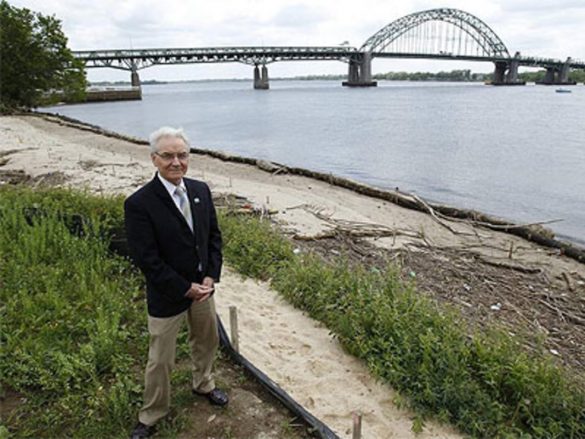Lardner’s Point: New city park is a plus for nature, too

Philadelphia Inquirer | By Sandy Bauers
Ever since the Tacony-Palmyra Bridge was built in 1928, a four-acre chunk of riverfront that served as a ferry terminal has lain vacant.
Trash has piled up, and invasive species have taken over. In 2004, the site was bathed with an unsavory brew of oil that spilled from the tanker Athos 1.
On Monday, city officials will celebrate the makeover of Lardner’s Point as the city’s newest park. More than just a pretty park on a pier, it is an ecological restoration that turned a concreted shoreline into a freshwater marsh, thick with plants and beneficial to wildlife.
Planners hope the project is the first of more to come. Cities nationwide are beginning to take their waterfronts back from the bulkheads, and various groups in this region are casting their eyes and tossing money at more than a few industrial waterfront sites they’d like to return to nature.
At Lardner’s Point, the invasives have been plucked and native species planted — 600 trees and shrubs, 8,000 plants. Instead of finding concrete rubble, birds and fish will find food and breeding habitat.
Humans will find picnic tables, park benches, a fishing pier, and a bicycle rack. Aiming for sustainability, planners had to ditch the idea for a composting toilet, but the lights are solar.
The park also is seen as a vital connector — to the neighborhood on the other side of I-95 and to a bike trail that one day could stretch not just from one end of Philadelphia to the other, but from Key West to Canada.
For now, it’s midway on a two-mile trail section that has been built along an old railway. “We saw the project as the perfect keystone to this little trail we were trying to push along as well,” said Patrick Starr, executive vice president of the Pennsylvania Environmental Council.
Because of industrialization and past environmental insults, “the Delaware riverfront in Philadelphia has been stripped of its natural resources and beauty,” Starr said. He called the new park “a model for what the future shoreline will look like.”
Other wetlands-restoration plans on the drawing board include Bridesburg and an 11-acre site downriver from Bristol. A plan for Penn Treaty Park includes osprey nesting platforms and bluebird houses.
The recently announced plan for 11 acres at the end of Pier 70 Boulevard includes “floating” wetlands among the old pier supports.
Wetlands filter and absorb storm water, slowing runoff and improving water quality — which is why the Philadelphia Water Department also has shown interest in restoring wetlands along the waterfront.
Lardner’s Point is also “an opportunity to reclaim the riverfront for those folks that live in the nearby communities,” said Thomas J. Branigan, executive director of the Delaware River City Corp., which has helped shepherd the project.
“Many of them haven’t even really seen the river,” Branigan said. “They’ve seen it from I-95.”
For all that, Lardner’s Point is tiny. Just 4.3 acres, and the marsh extends along only about 300 feet of shoreline.
Never mind, proponents say. “In the urban landscape, let’s be honest, we have to take what we can get,” said Danielle Kreeger, science director of the Partnership for the Delaware Estuary.
Kreeger likens Lardner’s Point to an oasis in a desert.
“If you’re a shad or a striper or a sturgeon swimming up the river along that urban riverfront that is heavily bulkheaded or riprapped, and you come across a tidal marsh with lots of things to eat, that’s a stopping point,” she said.
Time was, the riverfront from Chester to Trenton was like this. It’s called a freshwater tidal marsh — a rare ecological zone, as most tidal marshes are saltwater.
Although centuries of development have reduced these freshwater marshes to perhaps 5 percent of their former size, the Delaware estuary still has more acreage than anywhere else in the country, Kreeger said.
The Lardner’s Point project has been on the drawing boards for about a decade.
A few years ago, a group of regional restoration planners looked at various proposals in the estuary and ranked them according to which would bring the most benefit for the money.
“Every restoration dollar is so precious,” Kreeger said.
Lardner’s Point landed toward the top of the list, scoring high because it would restore urban waterfront and recreate tidal marsh.
Even though the city owned the land, it was a pricey project, costing a little more than $1.7 million. Areas contaminated by chemicals from a boat-repair operation had to be capped with clean soil.
The major funding source was the state Department of Conservation and Natural Resources, which chipped in nearly $750,000. Other money came from the city, the William Penn Foundation, the National Fish and Wildlife Foundation, and the Philadelphia Chapter of the Garden Club of America.
About $350,000 came from a $25 million restoration fund set up after the Athos 1 spill. An additional $327,000 from the fund will pay for five years of monitoring at the site.
Starr suggests the neighboring area might become attractive to development. He has long held that if you just get people onto the river, they’ll understand how wonderful it is, and they’ll want to protect it.
Last week, Branigan revisited the site, and people had already skirted the fence and were fishing from the pier. Birds flew by.
“Now, it’s kind of a quiet, serene spot,” he said. “You can sit on a bench and look out at the Tacony-Palmyra Bridge; you can see the boats in the river. … It’s a little bit of an escape from the city.”